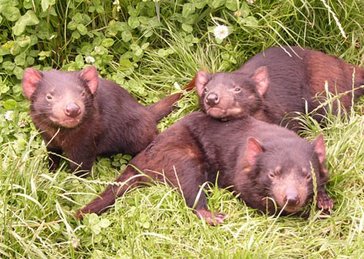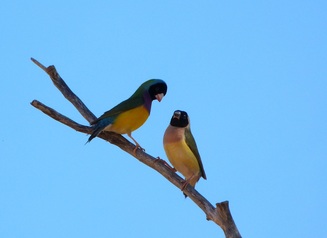Social Networks in Tasmanian Devils
 Photo credit - Catherine Young
Photo credit - Catherine Young
PhD project
Supervisors - Dr Rodrigo Hamede, Dr Menna Jones & Dr Elissa Cameron
Tasmanian devils (Sarcophilus harrisi), the worlds largest marsupial carnivores, are under severe threat of extinction due to a novel tranmissable cancer - devil facial tumour disease (DFTD). The mortality rate of devils which have contracted DFTD is close to 100%, and it has already spread to a high proportion of their native island of Tasmania. One of the key facets to mitigating the effects of the disease is developing a more complete understanding of how the disease is spread between individuals upon entering a population.
My PhD project aims to quantify social networks and behaviours associated with infection risk in wild Tasmanian devils, and investigate how this translates to bite injuries and transmission dynamics of Devil Facial Tumour Disease (DFTD). Over the next couple of years I will determine contact networks in a population of devils both pre- and post-DFTD arrival utilising proximity loggers - UHF collars which record when two individuals come within a pre-determined distance of one another. The contact distance at which the loggers are set (30cm) is such that they will record when devils are close enough to bite one another, and hence pass on the disease. To supplement this information devils will also be recaptured on a regular basis in order to check for new bite wounds, which can then be traced back to the individuals they have been in contact with. The network data obtained will be utilised to establish key disease parameters, such as latent period and the transmission likelihood of divergent strains of the disease, as well as whether infection causes any alterations to patterns of contact or behaviour within populations.
Devils are a species in extreme trouble, but thanks to the dedication of individuals and organisations commited to saving them, there is some light at the end of the tunnel. For more information on the great work being done to help the Tasmanian devil, both in the wild and via captive-breeding programs, see the following links -
Devil Ark captive breeding program - http://www.devilark.com.au
DPIPWE Recovery Plan - http://dpipwe.tas.gov.au/Documents/Draft-Tasmanian-Devil-Recovery-Plan.pdf
Supervisors - Dr Rodrigo Hamede, Dr Menna Jones & Dr Elissa Cameron
Tasmanian devils (Sarcophilus harrisi), the worlds largest marsupial carnivores, are under severe threat of extinction due to a novel tranmissable cancer - devil facial tumour disease (DFTD). The mortality rate of devils which have contracted DFTD is close to 100%, and it has already spread to a high proportion of their native island of Tasmania. One of the key facets to mitigating the effects of the disease is developing a more complete understanding of how the disease is spread between individuals upon entering a population.
My PhD project aims to quantify social networks and behaviours associated with infection risk in wild Tasmanian devils, and investigate how this translates to bite injuries and transmission dynamics of Devil Facial Tumour Disease (DFTD). Over the next couple of years I will determine contact networks in a population of devils both pre- and post-DFTD arrival utilising proximity loggers - UHF collars which record when two individuals come within a pre-determined distance of one another. The contact distance at which the loggers are set (30cm) is such that they will record when devils are close enough to bite one another, and hence pass on the disease. To supplement this information devils will also be recaptured on a regular basis in order to check for new bite wounds, which can then be traced back to the individuals they have been in contact with. The network data obtained will be utilised to establish key disease parameters, such as latent period and the transmission likelihood of divergent strains of the disease, as well as whether infection causes any alterations to patterns of contact or behaviour within populations.
Devils are a species in extreme trouble, but thanks to the dedication of individuals and organisations commited to saving them, there is some light at the end of the tunnel. For more information on the great work being done to help the Tasmanian devil, both in the wild and via captive-breeding programs, see the following links -
Devil Ark captive breeding program - http://www.devilark.com.au
DPIPWE Recovery Plan - http://dpipwe.tas.gov.au/Documents/Draft-Tasmanian-Devil-Recovery-Plan.pdf
Colour Communication in Frillneck Lizards
|
Research project assistant
Collaborators - Dr Sarah Pryke, Dr Martin Whiting, Dr Nina Svedin, Dr Thomas Merkling, Dr Mitzy Pepper, Bori Cser & Dr Scott Keogh My previous work involved investigation of colour communication in the iconic frillneck lizard (Chlamydosaurus kingii). Frillneck lizards occur in 3 distinct colour morphs (see slideshow on right) that are geographically separated across the Top End of Australia - red/orange frill morphs are found in the Kimberley region of WA, the NT and western QLD, yellow frill morphs in north-east QLD, while morphs with white frills are found in south-east QLD. We determined that males of the Kimberley red/orange morphs utilise the colouration in their frill as an honest signal to display their competitive ability to rival males (see Hamilton, Whiting & Pryke, 2013; link to PDF below). Data on morphology and colour attributes, as well as genetic data, are currently being analysed in order to assess whether there are inherent differences between morphs that go beyond colouration. Related Publications Hamilton DG, Whiting MJ & Pryke SR. 2013. Fiery frills: carotenoid-based coloration predicts contest success in frillneck lizards. Behav Ecol 24(5):1138-1149. |
|
Other Research Experience
 Photo credit - David Hamilton
Photo credit - David Hamilton
Conservation and Population Monitoring of Gouldian (Erythrura gouldiae) and Long-tailed Finches (Poephila acuticauda)
with Dr Sarah Pryke, Catherine Young & Save The Gouldian Fund
Cognition and Brain Size in Cane Toads (Rhinella marina)
with Dr Martin Whiting
The Impact of Cane Toads (Rhinella marina) on Goannas in Australia's Top End
with Dr Sean Doody
Related Publication: Doody JS, James H, Ellis R, Gibson N, Raven M, Mahoney S, Hamilton DG, Rhind D, Clulow S & McHenry CR (2014). Cryptic and Complex Nesting in the Yellow-Spotted Monitor, Varanus panoptes. J. Herpetol. 48(3):1-8.
Evolution of Cooperative Behaviour in Meerkats (Suricata suricatta)
at Kalahari Meerkat Project
Seabird Monitoring on Handa Island
with the Scottish Wildlife Trust
Conservation and Population Monitoring of the Endangered Mauritian Pink Pigeon (Columba mayeri)
with the Mauritian Wildlife Foundation
with Dr Sarah Pryke, Catherine Young & Save The Gouldian Fund
Cognition and Brain Size in Cane Toads (Rhinella marina)
with Dr Martin Whiting
The Impact of Cane Toads (Rhinella marina) on Goannas in Australia's Top End
with Dr Sean Doody
Related Publication: Doody JS, James H, Ellis R, Gibson N, Raven M, Mahoney S, Hamilton DG, Rhind D, Clulow S & McHenry CR (2014). Cryptic and Complex Nesting in the Yellow-Spotted Monitor, Varanus panoptes. J. Herpetol. 48(3):1-8.
Evolution of Cooperative Behaviour in Meerkats (Suricata suricatta)
at Kalahari Meerkat Project
Seabird Monitoring on Handa Island
with the Scottish Wildlife Trust
Conservation and Population Monitoring of the Endangered Mauritian Pink Pigeon (Columba mayeri)
with the Mauritian Wildlife Foundation
